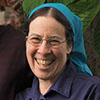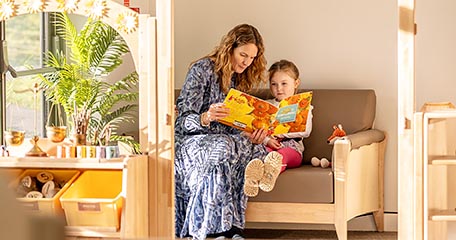The book corner
| September 2018Two-year-old Roderick’s key person held him on her lap while she read Shirley Hughes’ Alfie Gets in First. Roderick’s eyes were big and serious throughout the crisis, and he held his body rigid. When the critical moment was resolved, Roderick’s whole body relaxed and he laughed aloud. Then he wanted to hear the story again.
Sharing this book strengthened the positive relationship between Roderick and his key person, who realised that he is capable of mentally and emotionally putting himself in another’s situation. She also learned that Roderick, normally a boisterous child, can be focused and quiet when his interest is engaged.

Books have a tremendous influence on many areas of learning. They can introduce themes of friendship, diversity, and overcoming challenge, thus helping to develop character. They can expand children’s knowledge of the world, other people, cultures and traditions, or they can introduce imaginary themes. It is said that the best way to strengthen children’s intelligence is to read them fairy tales.
The book corner should be in the quietest part of the room and include at least one small nook for children who want solitary space. It should be protected on three sides by walls, shelves, or room-dividing panels. Carpet or rugs and soft seating or cushions add a cosy feel, and an arch or some fabric overhead make the area inviting. A window panel and puppets can link the book area to role play if desired.
Book corner learning and development observations:
Communication and Language
Listening and attention
- Babies respond to hearing nursery rhymes or singing.
- When stories are told or read aloud, children learn to listen attentively, anticipate events, and respond to what they hear with comments, questions or actions.
- They learn non-verbal communication through body language and facial expression.
Understanding
- Children ask “how” or “why” in response to stories, providing learning opportunities.
- Children learn to make connections with their own experiences.
Speaking
- Stories lead to conversations, empowering children to express their own ideas.
- Repetition of stories and poems establishes the basics of language in children’s minds and reinforces learning. Children may recite familiar phrases.
- Children learn enjoyment of language, including humour and word play. They love to use big words and will often adopt vocabulary from books.

Physical development
Health and self-care
- Children will discuss ways to keep healthy and safe if the topic is introduced in a story.
- Children enjoying books may be experiencing quiet rest which is essential for healthy physical development.
Personal, social and emotional development
Managing feelings and behaviour
- Through stories, children build empathy. They may shiver with suspense or delight according to the story-book characters’ experience. They acknowledge how others feel.
- Some stories deal with emotions explicitly; others (such as fairy tales) deal with feelings implicitly, allowing children to safely explore fear, anger, grief, or anxiety.
Making relationships
- Sharing books builds a positive relationship between key person and child.
- Enjoying a good book with a group of children strengthens group solidarity.
Literacy
Reading
- In books, children see plainly that writing tells a story. They become intrigued and eager to unlock the code themselves.
- Children may begin to link sounds and letters if they look at the writing while a book is being read aloud.
- Children can learn valuable literacy skills – context, sequencing, and searching for meaning –from picture books (with or without text).
Writing
- Books inspire children to tell their own stories; an adult scribing these stories demonstrates the link between spoken and written language.
- Children may be inspired to create books, including their own illustrations and simple words (or captions added by the teacher).
- Early mark making is often story-telling by children.
- Children will begin writing when they are developmentally ready.

Understanding the world
People and communities
- Books and stories stimulate discussion on similarities and differences between children, their families, communities, and traditions.
- Books in different scripts provide opportunity to recognise similarities and differences.
The world
- Books teach children about other lands, communities and cultures. Discussion follows naturally.
- A good variety of books will feed individual interests, enabling children to learn about animals and plants for instance, and extending their understanding of the world – and the universe.
Expressive art and design
Being imaginative
- Books may inspire children to act out stories through role play, puppets or dance.
- Children’s expressive art and design may be stimulated by picture book illustrations.
- Stories are often reflected in children’s art and block play.





